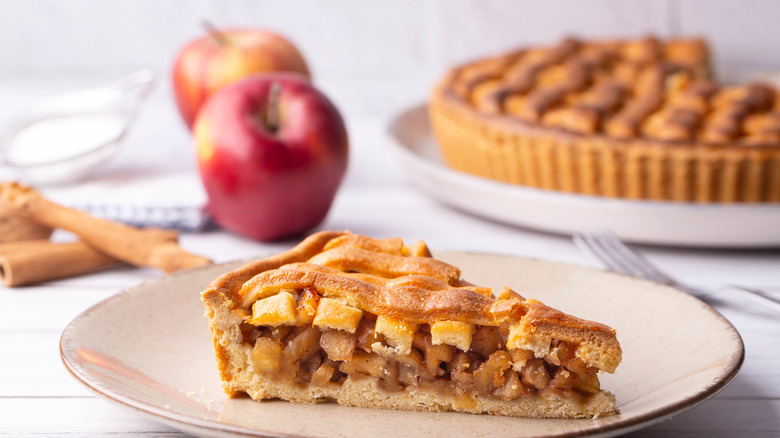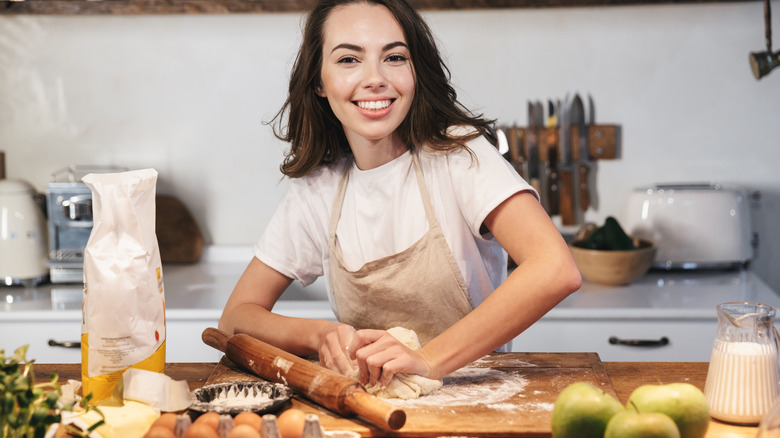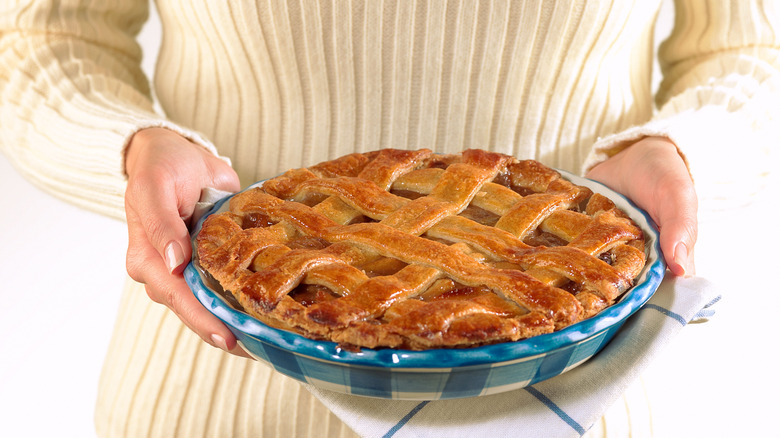How Many Apples Do You Need For Apple Pie?
If you ask any American what their favorite flavor of pie is, the American Pie Council reports nearly one out of five will say apple. This king of pies is a staple at diners and bakeries year-round, but it's especially in demand at the end of the summer and into the fall when apples come into season in North America. The trouble when you're shopping for apple pie supplies, however, is guessing how many you'll need to make an eight- or nine-inch pie. Depending on the variety you're using, a good rule of thumb is to get around eight to 10 apples for each pie.
Apples can vary a lot in size, and not all recipes call for the same amount of apples, but if you're making an easy apple pie, you'll need enough fruit to fill out the pan while also keeping in mind that the apples will cook and break down, and thus lose volume. If you're out at an apple orchard, or you're eyeing a pile of ripe Courtlands at the farmer's market, it's easy to over or underestimate how much fruit you'll need. If you stick to around eight to 10 apples, you'll almost always have the exact amount of fruit for a standard-sized pie.
Use your fist as measurement
Apple pies are extremely simple recipes, especially if they're made with a double pie crust. All you need is flour, butter, sugar, cinnamon, and nutmeg, plus a few tablespoons of water for mixing the crust, and of course some apples. When you're choosing apples, keep in mind that a standard-sized pie plate will hold about 10 cups of peeled, sliced apples.
Of course, some apples are smaller and others are larger, but that's okay — just remember that whenever you need to measure anything for volume when you're at the grocery store or farmer's market, your fist is about the size of one cup. Fists do tend to be smaller and larger, too, so at some point when you're cooking, get a one-cup dry measuring cup out and put your hand around it. Now, commit to memory about how big it feels in your hand. When you're out shopping, you'll always have a good idea of what one cup looks like. This comes in handy a lot, especially if you're shopping for fresh produce, items in bulk like grains or nuts and seeds, and even for salad greens (just grab the greens with your hand and give them a light squeeze like you're packing them into a cup).
Account for some loss
Fresh, raw apples won't measure a perfect cup when you get them home and process them for making pie, even if they look like they're around the same size as a cup. You'll lose about 30% of the apples after you peel and core them, so get one more apple than you think you need to make up for that loss. So if you're aiming for eight cups, and the apples are all about the size of a cup (or your fist), get nine apples. If the apples are a little smaller than a cup or your fist, get two extras, and if the apples are much bigger than your fist, get one or two less.
Once you get the apples home and before you start peeling and cutting, it's good to do a quick visual check by piling the apples into the pie plate to see how many fit. While keeping in mind that you'll lose 30%, prep only as many apples as fit in the pan. They can be on top of each other but don't pile them any higher than two layers. That way, you don't waste any apples that don't fit. But if you do have extra apples, and some extra crust from trimming the edges before crimping, you can always use them to make a quick handheld pie, which is a great little reward for doing all the work of making tonight's dessert.


